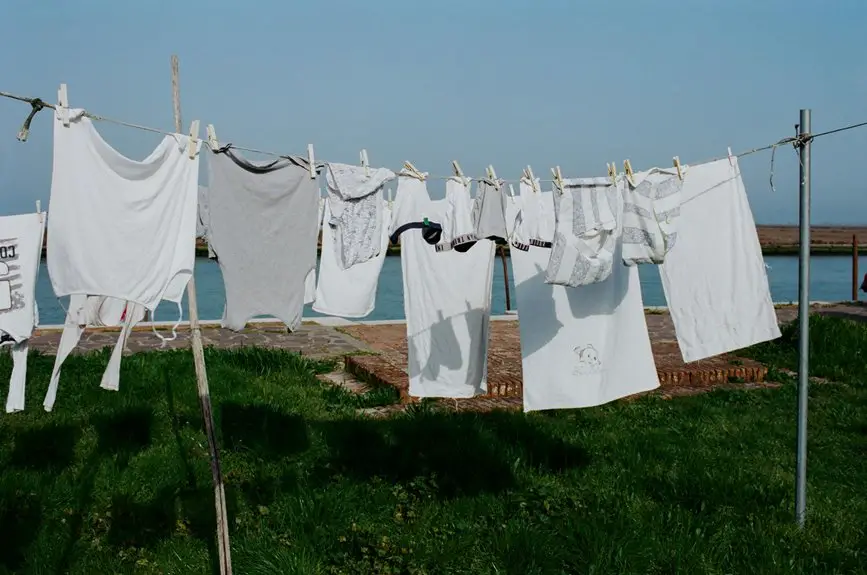To prevent shrinking and damage when washing gauze fabric, use cold or lukewarm water with a mild, fragrance-free detergent. Hand wash gently or machine wash on a delicate cycle inside a mesh bag to reduce agitation. Avoid wringing or twisting the fabric, and air dry it promptly to preserve its airy texture and softness. Taking these careful steps protects the fabric’s durability and breathability. If you want to maintain gauze fabric’s quality long-term, there are additional care tips to explore.
Table of Contents
Key Takeaways
- Use mild, fragrance-free detergent and cold or lukewarm water to avoid fiber weakening and shrinking.
- Hand wash gauze fabric gently or use a mesh laundry bag with a delicate cycle in the machine.
- Avoid wringing or twisting the fabric to maintain its shape and prevent stretching.
- Air dry gauze fabric flat or hang it to dry, avoiding direct sunlight and high heat.
- Check care labels and pre-treat stains gently by blotting with diluted detergent, not rubbing.
Understanding the Characteristics of Gauze Fabric
Although gauze fabric looks delicate, it’s surprisingly durable and breathable, making it ideal for various uses.
When you handle gauze, you’ll notice its loose, open weave creates a lightweight texture that’s gentle on your skin. This fabric’s breathability guarantees comfort, especially in warm weather or for baby clothing and medical bandages.
However, because of its airy structure, gauze can snag or stretch if you’re not careful. It’s typically made from cotton or a cotton blend, which adds to its softness but also means it can shrink if washed improperly.
Understanding these traits helps you treat gauze gently, preserving its shape and feel. Knowing how gauze behaves allows you to wash it without compromising its unique qualities.
Preparing Gauze Fabric for Washing
Before washing your gauze fabric, always check the care labels to follow specific instructions.
If you spot any stains, pre-treat them gently to avoid damaging the delicate fibers.
Taking these steps guarantees your fabric stays in great condition through the wash.
Check Fabric Care Labels
When you’re preparing to wash gauze fabric, you should check the fabric care labels carefully to understand the recommended washing methods and temperature settings.
These labels provide essential information about whether the fabric can be machine washed or if hand washing is necessary. They also specify the ideal water temperature to prevent shrinking or damage—usually cold or lukewarm water is safest for gauze.
Additionally, the labels may advise against using bleach or certain detergents that could weaken the fibers. Pay attention to drying instructions too; some gauze fabrics need air drying to maintain their texture.
Pre-Treat Stains Gently
After checking the care labels, you’ll want to handle any stains on your gauze fabric with care to avoid damaging its delicate fibers.
Start by gently blotting the stain with a clean cloth to lift excess residue without rubbing. Then, use a mild stain remover or a solution of water and gentle detergent, applying it softly with your fingertips or a soft brush.
Avoid harsh chemicals or vigorous scrubbing, which can weaken the fabric.
Here’s how to pre-treat stains effectively:
- Blot, don’t rub, to prevent fiber damage
- Use a diluted, mild detergent or stain remover
- Test the treatment on a hidden area first
This careful approach preserves the gauze’s texture and prevents shrinkage during washing.
Choosing the Right Detergent and Water Temperature
Selecting the right detergent and water temperature plays a crucial role in maintaining the softness and durability of gauze fabric. You want to avoid harsh detergents with strong chemicals, which can weaken fibers and cause fading. Instead, choose a mild, fragrance-free detergent made for delicate fabrics. As for water temperature, cold or lukewarm water is best to prevent shrinking and preserve the fabric’s airy texture.
| Detergent Type | Water Temperature | Effect on Gauze Fabric |
|---|---|---|
| Mild, fragrance-free | Cold (30°C/86°F) | Soft, maintains durability |
| Harsh, scented | Hot (above 40°C) | Fades color, weakens fibers |
| Enzyme-based | Warm (up to 40°C) | Risk of damage, avoid |
| Powder | Cold | May not dissolve fully |
| Liquid | Cold or lukewarm | Gentle, effective cleaning |
Best Washing Methods for Gauze Fabric
Choosing the right detergent and water temperature sets the foundation, but how you wash gauze fabric matters just as much. To keep your gauze soft and intact, handle it gently throughout the washing process.
Start by turning the fabric inside out to protect its delicate surface. Use a mesh laundry bag if you’re machine washing to prevent snagging or stretching. Always select a gentle cycle to minimize agitation and reduce wear.
Here are the best washing methods for gauze fabric:
- Hand wash in cool water with mild detergent for maximum care.
- If using a machine, choose a delicate or gentle cycle.
- Avoid wringing or twisting the fabric to prevent distortion.
Following these tips helps maintain your gauze’s texture and shape over time.
Drying Techniques to Maintain Fabric Integrity
To keep your gauze fabric in great shape, you’ll want to choose the right drying method.
Air drying is gentle and helps preserve the fabric’s texture, while machine drying requires careful temperature control to avoid damage.
Let’s compare these options and find the best way to dry your gauze without compromising its quality.
Air Dry vs. Machine
While both air drying and machine drying can remove moisture from gauze fabric, each method impacts the material’s texture and longevity differently.
You’ll find air drying is gentler, preserving the fabric’s softness and preventing shrinkage. On the other hand, machine drying speeds up the process but risks damaging delicate fibers if not done carefully.
Consider these points to decide which method suits your gauze fabric best:
- Air drying keeps the gauze’s lightweight, airy feel intact and reduces wear over time.
- Machine drying can cause the fabric to stiffen or shrink if the cycle is too intense.
- Air drying takes longer but minimizes the chance of fabric distortion or color fading.
Choosing the right drying method helps maintain your gauze fabric’s quality for longer.
Optimal Temperature Settings
Even if you prefer machine drying, setting the temperature correctly plays an essential role in preserving your gauze fabric’s softness and preventing damage.
Always opt for the lowest heat setting or a delicate cycle to minimize the risk of shrinking and fabric weakening. High heat can cause the fibers to tighten and lose their airy texture, so avoid it altogether.
If your dryer has an “air fluff” or “no heat” option, that’s even better for maintaining the fabric’s integrity. Remember, gauze dries quickly, so shorter drying times reduce exposure to heat.
To keep your gauze looking fresh and soft, remove it promptly once dry and avoid over-drying. Following these temperature guidelines helps your gauze fabric stay comfortable and durable for longer.
Tips for Storing and Caring for Gauze Fabric
Caring for gauze fabric starts with how you store it—proper storage can extend its lifespan and maintain its softness.
Proper storage is key to preserving gauze fabric’s softness and extending its lifespan.
First, always keep gauze in a cool, dry place to prevent mildew and odors. Avoid direct sunlight, which can weaken fibers and fade colors. When folding, be gentle to avoid creases that damage the delicate weave.
To care for your gauze fabric effectively:
- Store it loosely folded or rolled to minimize wrinkles and stress on fibers.
- Use breathable fabric bags instead of plastic to allow airflow and prevent moisture buildup.
- Keep it away from sharp objects and heavy items that might snag or crush the fabric.
Following these tips helps preserve your gauze fabric’s texture and durability for longer use.
Frequently Asked Questions
Can Gauze Fabric Be Ironed Without Damaging It?
Ironing gauze fabric is like gently brushing a butterfly’s wings—you can do it, but you must be delicate. Use a low heat setting and a pressing cloth to avoid scorching or crushing the airy texture.
Is It Safe to Bleach Gauze Fabric if Heavily Stained?
You shouldn’t bleach gauze fabric, even if heavily stained, because bleach weakens fibers and causes damage. Instead, try a gentle stain remover or soak with mild detergent to keep your gauze safe and intact.
How Often Should Gauze Fabric Be Washed for Hygiene?
You should wash gauze fabric after every use to maintain hygiene. Frequent washing prevents bacteria buildup and keeps it fresh. Just make sure you handle it gently to avoid wear and tear over time.
Can Gauze Fabric Be Machine Dried on Low Heat?
You can machine dry gauze fabric on low heat, but it’s safer to air dry when possible. Low heat minimizes shrinking and damage, but being gentle helps keep the fabric soft and durable over time.
Are There Specific Brands of Detergent Best for Gauze Fabric?
You wouldn’t use a quill to write an email, right? Similarly, pick gentle, fragrance-free detergents like Woolite or Seventh Generation for gauze fabric. They’ll keep it soft without harsh chemicals that cause damage or shrinkage.
- Kevlar Fabric Samples: Testing Before Purchase - June 21, 2025
- Kevlar Roll in Chicago: Finding Quality Suppliers - June 21, 2025
- Kevlar Fabric Resin Compatibility: Choosing the Right Adhesives - June 21, 2025







